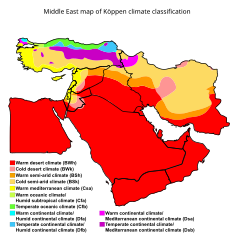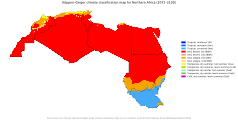Climate change in the Middle East and North Africa
Climate change in the Middle East and North Africa (MENA) refers to changes in the
Sharp global temperature and sea level changes, shifting precipitation patterns and increased frequency of extreme weather events are some of the main impacts of climate change as identified by the Intergovernmental Panel on Climate Change (IPCC).[9] The MENA region is especially vulnerable to such impacts due to its arid and semi-arid environment, facing climatic challenges such as low rainfall, high temperatures and dry soil.[9][10] The climatic conditions that foster such challenges for MENA are projected by the IPCC to worsen throughout the 21st century.[9] If greenhouse gas emissions are not significantly reduced, part of the MENA region risks becoming uninhabitable before the year 2100.[11][12][13]
Climate change is expected to put significant strain on already scarce water and agricultural resources within the MENA region, threatening the national security and political stability of all included countries.[14] Over 60 percent of the region's population lives in high and very high water-stressed areas compared to the global average of 35 percent.[15] This has prompted some MENA countries to engage with the issue of climate change on an international level through environmental accords such as the Paris Agreement. Law and policy are also being established on a national level amongst MENA countries, with a focus on the development of renewable energies.[16]
Greenhouse gas emissions

As of January 2021, the
Greenhouse gas emissions produced by humans have been identified by the IPCC and the vast majority of climate scientists as the primary driver of climate change.[19][9] In the past three decades, the MENA region has more than tripled its greenhouse gas emissions and is currently emitting above the global average per person, with most of the top ten countries by carbon dioxide emissions per person being found in the Middle East.[20][4] These high emissions levels can be primarily attributed to Saudi Arabia and Iran, which are the 9th and 7th largest emitters of CO2 in the world, accounting for 40% of the region's emissions in 2018.[4] MENA countries heavily rely on fossil fuels for the generation of electricity, sourcing 97% of their energy from oil, natural gas, and coal (in Turkey).[21] Fossil fuel extraction, production and exportation is also a significant component of many economies within the MENA region, which possesses 60% of the world oil reserves and 45% of known natural gas reserves.[22] Reducing gas flaring would help.[23]
The failure of the
Impacts on the natural environment
Temperature and weather changes
Heat extremes
The IPCC project average global temperatures to rise more than 1.5 degrees by the end of the 21st century.[9] MENA has been identified as a hotspot for future temperature changes due to its arid environmental conditions.[27] Whilst projected rates of warming during winter months are low, the region is expected to experience extreme temperature increases during summer.[28][29] Temperature rises are expected to be further amplified by reductions in rainfall and the associated depletion of soil moisture, limiting evaporative cooling.[30] As a result, heat extremes are expected to increase significantly in both frequency and intensity across the MENA region. According to studies published by the Max Planck Institute for Chemistry, the number of very hot days in the region has doubled between the 1970s and the time when the report was published (2016).[28] The study further projects that heatwaves will occur for 80 days of the year by 2050 and 118 days of the year by 2100.[28] Considering also increased sandstorms associated with longer drought periods, even a 2 degree temperature rise would make large parts of the region uninhabitable and force people to migrate.[28][31] Limiting temperature rise to 1.5 degrees, will significantly reduce risks for the region.[32]
The average maximum temperature during the hottest days of the past 30 years has been 43 degrees Celsius.[10] Dutch atmospheric chemist Johannes Lelieveld has projected that temperature maximum's could reach almost 50 degrees Celsius under current climate scenarios established by the IPCC.[30] Johannes Lelieveld further projects that average summer temperatures are expected to increase by up to 7% across the MENA region, and up to 10% in highly urbanised areas.[30] Extreme heat has been identified as a serious threat to human health, heightening an individual's susceptibility to exhaustion, heart attack and mortality.[33] Climate scientist Ali Ahmadalipour has projected heat-related mortality rates within the MENA region to be up to 20 times higher than current rates by the end of the century.[34]
- Köppen climate classification of MENA in the present and the future (most intense climate change scenario)
-
Western Asia in the present
-
Western Asia in the future
-
Northern Africa in the present
-
Northern Africa in the future
Water resources

The Middle East and North Africa currently faces extreme water scarcity, with twelve out of the 17 most water stressed countries in the world deriving from the region.[35] The World Bank defines an area as being water stressed when per person water supplies fall below 1,700 cubic metres per year.[36] The water supply across the MENA region is averaged at 1274 cubic metres per capita, with some countries having access to only 50 cubic metres per person.[14] The agricultural sector within the MENA region is heavily dependent on irrigation systems due to its arid climate, with 85% of fresh water resources being utilised for agricultural purposes.[37][38] The IPCC indicate that the global distribution of rainfall is currently shifting in response to increasing greenhouse gas emissions, with increases in high latitude and mid-latitude wet region and decreases in equatorial dry regions such as the MENA.[9] These shifting precipitation patterns have already placed significant strain on MENA agriculture, with the frequency and severity of droughts rising significantly in the past decade.[39]
A recent NASA study suggests that the 1998–2012 drought in the Middle East was the worst to occur in the past 900 years.[40] Climate scientist Colin Kelley suggests that climate change was a significant contributor to the increased severity of the most recent drought in the region. He claims that such drought is 3 times more likely to occur due to human influence on climate and the drought have contributed to the beginning of the Syrian civil war.[41] Along with environmental impacts, increasing drought periods affect agricultural incomes, diminishes public health and weakens political stability in the MENA region.[42] Syria experienced its most severe drought on record from 2007 to 2010, where restricted water supply degraded agricultural resources and increased economic pressures.[41][43] American environmental scientist Peter Gleick also asserts that heightened social vulnerability and conflict over scare water supplies during this period catalysed the onset of the Syrian war.[43]
However, in 2017, a study led by sociologist and political ecologist Jan Selby has discredited these claims, reporting that there is no solid evidence that climate change is associated with the drought, the same about the impact of the drought on the conflict in Syria.[44] In 2019 Konstantin Ash and Nick Obradovich published research indicating that extreme drought was one of the leading factors in the creation of the Syrian war.[45]
Increasing water insecurity as a result of climate change is set to exacerbate existing
Sea level rise
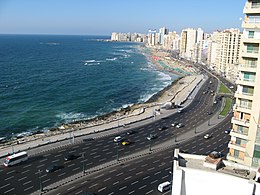
Alexandria is one of the most vulnerable cities to sea level rise.[11]
Across the MENA region, 60 million people inhabited coastal areas in 2010, a population that has been predicted by the World Bank to grow to 100 million by 2030.
In North Africa, Egypt is expected to be most affected by changes in sea level.[50] A third of the Nile Delta and large parts of Alexandria, Egypt's second-largest city, lie below the mean global sea level.[52] These areas have been drained for agricultural purposes and undergone urban development, where inundation and flooding is prevented by sea walls and dams.[52] However, failures occurring in these structures, storm surges and extreme weather events could lead to the inundation of these areas in the future if sea levels continue to rise.[52] Agricultural areas in Egypt are particularly at risk, where a one-metre rise in sea level would submerge 12–15% of the nation's total agricultural land.[53] This is estimated to displace 6.7 million people in Egypt and affect millions more who rely on agriculture for income.[53] A more moderate 50 cm increase in sea level has been projected to displace 2 million people and generate US$35 billion of damages.[54]
Mitigation and adaptation
The severe impacts of climate change on the region, made climate change mitigation and adaptation an important issue in it. Regional cooperation is considered as one of the main conditions for effective mitigation and adaptation.[55][56]
Renewable energy
The MENA region possesses high potential for developing renewable energy technologies due to the high levels of wind and sunshine that are associated with its climate.[57] The International Renewable Energy Agency (IRENA) has identified over half of all land in GCC states as being suitable for the deployment of solar and wind technologies.[58] IRENA has also identified North African countries as having greater potential for wind and solar energy generation than all other regions of the continent.[59] Sourcing energy from renewable technologies instead of fossil fuels could significantly reduce energy related GHG emissions, which presently account for 85% of total emissions within the MENA region.[60][61] Renewable energy generation also involves significantly less water usage than processes associated with fossil fuel extraction and its conversion into usable energy, possessing the potential to improve water quality and availability within the region.[62][63] Renewable energy presently accounts for 1% of the total primary energy supply across the MENA region.[64]
At the 2016 UN Climate Change Conference in Marrakech, Morocco (COP22), Morocco, Tunisia, Yemen, Lebanon and the State of Palestine, along with 43 other countries, committed to deriving all energy from renewable resources by 2050.[65][66]
Ouarzazate Solar Power Station
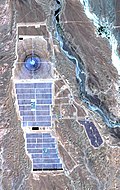
The
Policies and legislation
Paris Agreement

Eleven countries from the MENA region attended the 21st Conference of the Parties of the UNFCCC where countries negotiated the Paris Agreement, an agreement with the United Nations concerning greenhouse gas emissions mitigation. As of 2021[update] Eritrea, Iran, Iraq, Libya, and Yemen are the only countries in the world which have not ratified the agreement.[70] Morocco has set its nationally determined contribution to a 17%-42% reduction in emissions and has set a target of having 52% of renewable energy in its total installed electricity production capacity by 2050.[71] The share of renewable energy reached 28% in 2018 and is currently recognised by the United Nations as being on track to achieving its renewable energy targets.[72] The UAE, despite ratifying the agreement, have set no reduction in emissions in their nationally determined contribution. The United Nations have identified their NDC target as "critically insufficient".[73]
MENA Climate Action Plan
In 2016 the World Bank put forth the MENA Climate Action Plan, a series of financial commitments centred around the redistribution of finance to the MENA region.[74] The World Bank deemed the plan's core focus to be ensuring food and water security, increasing resilience to climate change impacts and improving investment in renewable energy source.[74] One of the Action Plan's major commitments was to allocate 18-30% of MENA finance towards climate related initiatives, which currently stands a $1.5 billion annually. The World Bank have also outlined a significant increase in funding directed towards adaptation initiatives such as water conservation and recycling, introduction of desalination facilities and investment into carbon sequestration technologies.[74]
By country
Algeria


Egypt
Iran

Iran is among the most vulnerable countries to climate change in the Middle East and North Africa (MENA). Iran contributes to about 1.8% of global greenhouse gas emissions (GHG), and is ranked 8th in greenhouse gas emissions (GHG) world wide and is ranked first in the MENA region due to its reliance on oil and natural gas. Climate change has led to reduced precipitation as well as increased temperatures, with Iran holding the hottest temperature recorded in Asia.[83]
The country is facing water shortages with around 35% of Iranians experiencing
Iraq
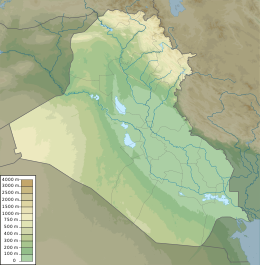 | |
| Continent | Asia |
|---|---|
| Region | Middle East |
| Coordinates | 33 00 N, 44 00 E |
| Area | Ranked 60 |
| • Total | 438,317 km2 (169,235 sq mi) |
| Coastline | 58 km (36 mi) |
| Borders | Turkey to the north, Iran to the east, the Persian Gulf and Kuwait to the southeast, Saudi Arabia to the south, Jordan to the southwest, and Syria to the west. |
| Highest point | Cheekha Dar 3,611 m (11,847 ft) |
| Lowest point | Persian Gulf 0 m (0.0 ft) |
| Longest river | Euphrates |
| Largest lake | Lake Tharthar |
| Natural resources | Petroleum, sulfur, phosphate, and natural gas.[88] |
In Iraq,
Water-related challenges are at the forefront of Iraq's environmental problems. Models predict that precipitation will decrease by 9% and mean annual temperatures will increase by 2°C by 2050.[91] The flow of the Tigris and Euphrates rivers, which provide 98% of Iraq's surface water, has decreased by 30-40% in the past 40 years.[92] The water resources of these two rivers are also shared with neighboring countries. Iraq's water supplies have significantly decreased over time due to dam construction from upstream nations.[93]
In 2019 Iraq contributed 0.5% to global carbon emissions.[94] Iraq's energy sector and fugitive emissions account for three-fourths of the nation's emissions.[94] Specifically, Iraq's oil and gas sectors produced 9% of global methane emissions in 2019, a portion of which is from gas flares.[89] The waste, industrial, and agriculture sectors are the other sectors contributing to Iraq's greenhouse gas emissions.
Iraq produced an Intended Nationally Determined Contribution (INDC), which is a set of policies and goals for how Iraq can address climate change. Iraq wants to reduce emissions by 15% by 2035, with a specific focus on lowering their methane emissions.[95] Iraq ratified the Paris Treaty in 2021 and committed to specific actions to reduce methane emissions in the oil and gas sector, which are coordinated by a newly established inter-ministerial national task force on methane emissions.[96]Israel
This section needs expansion. You can help by adding to it. (May 2020) |
According to the Ministry of Environmental Protection of Israel: "While Israel is a relatively small contributor to climate change due to its size and population, it is sensitive to the potential impacts of the phenomenon, due to its location. Thus, it is making an effort to reduce greenhouse gas emissions while simultaneously doing whatever possible to reduce the expected damage that will result if climate change is not halted."[97]
The impacts of climate change are already felt in Israel. The temperature rose by 1.4 degrees between 1950 and 2017. The number of hot days increased and the number of cold days decreased.[clarification needed] Precipitation rates have fallen. The trends are projected to continue. By the year 2050, in the coastal area the number of days with maximal temperature above 30 degrees, per year, is projected to increase by 20 in the scenario with climate change mitigation and by 40 in "business as usual" scenario.[98]
Israel ratified the Paris Agreement in 2016. The country is part of 3 initiatives on mitigation and adaptation and 16 other actions taken by non-governmental organisations.[99]
According to Israel's
Jordan
Kuwait
Morocco

Sudan

In Sudan, climate change has caused an increase in temperatures, a decline in rainfall and driven desertification.[110] Climate change poses significant challenges for rainfed agriculture and therefore the entire economy.[111] Analysis of weather patterns suggest drought conditions and other extreme weather increased in Sudan during the 20th century.[112] The relationship between climate change, water conflict and the war in Sudan has also been a topic of academic debate.[113]
Syria
Turkey
United Arab Emirates
See also
Further reading
- Ide, Tobias (2018-12-01). "Climate War in the Middle East? Drought, the Syrian Civil War and the State of Climate-Conflict Research". Current Climate Change Reports. 4 (4): 347–354. S2CID 159017324.
- Sowers, Jeannie; Vengosh, Avner; Weinthal, Erika (2010-04-23). "Climate change, water resources, and the politics of adaptation in the Middle East and North Africa". Climatic Change. 104 (3–4): 599–627. S2CID 37329318.
Notes
References
- PMID 31996825.
- .
Medium-range estimates of Arctic carbon emissions could result from moderate climate emission mitigation policies that keep global warming below 3°C (e.g., RCP4.5). This global warming level most closely matches country emissions reduction pledges made for the Paris Climate Agreement...
- The Australian Academy of Science, for instance, released a report last year stating that our current emissions trajectory had us headed for a 3°C warmer world, roughly in line with the middle scenario. Climate Action Trackerpredicts 2.5 to 2.9°C of warming based on current policies and action, with pledges and government agreements taking this to 2.1°C.
- ^ a b c "CO2 Emissions". Global Carbon Atlas. Archived from the original on Oct 11, 2020. Retrieved 2020-04-10.
- ^ "Population, total – Middle East & North Africa, World". World Bank Open Data. Retrieved 2020-04-11.
- (PDF) from the original on Jun 14, 2021 – via Surrey Research Insight Open Access.
- ISSN 0360-5442.
- ISSN 2211-467X.
- ^ a b c d e f IPCC, 2014: Climate Change 2014: Synthesis Report. Contribution of Working Groups I, II and III to the Fifth Assessment Report of the Intergovernmental Panel on Climate Change [Core Writing Team, R.K. Pachauri and L.A. Meyer (eds.)]. IPCC, Geneva, Switzerland, 151 pp.
- ^ ISBN 9781781950258.
- ^ a b Broom, Douglas (5 April 2019). "How the Middle East is suffering on the front lines of climate change". World Economic Forum. Retrieved 4 February 2020.
- ^ Gornall, Jonathan (24 April 2019). "With climate change, life in the Gulf could become impossible". Euroactive. Retrieved 4 February 2020.
- ISSN 1758-678X.
- ^ S2CID 134523218.
- PMID 35729894.
- ISBN 978-3-642-28625-4
- ^ "Middle East and North Africa". unicef.org. UNICEF. Archived from the original on 27 November 2020. Retrieved 16 January 2021.
- ^ Nuno Santos & Iride Ceccacci (2015). "Egypt, Jordan, Morocco and Tunisia: Key trends in the agrifood sector" (PDF). fao.org. FAO. Retrieved 16 January 2021.
- ISSN 1748-9326.
- )
- ^ menara. "The MENA Region in the Global Energy Markets". Menara Project. Archived from the original on 2018-11-16. Retrieved 2020-04-24.
- ^ Bridle, Richard, L. Kitson, and Petre Wooders. "Fossil-fuel subsidies: A barrier to renewable energy in five Middle East and North African countries." GSI Report (2014): 8-9.
- ISSN 2211-467X.
- ^ "Iran: Largest Fuel Subsidizer in 2018". Financial Tribune. July 16, 2019.
- ^ "AP Explains: Iran gas price protests quickly turn violent". AP NEWS. 2019-11-18. Retrieved 2020-05-11.
- ^ "How Reforming Fossil Fuel Subsidies Can Go Wrong: A lesson from Ecuador". IISD. Retrieved 2020-05-11.
- ISBN 978-2-7099-2219-7
- ^ ISSN 0165-0009.
- ISSN 1674-9278.
- ^ ISSN 1436-3798.
- ^ "Climate-exodus expected in the Middle East and North Africa". MAX-PLANCK-GESELLSCHAFT. the Max Planck Institute for Chemistry and the Cyprus Institute in Nicosia. Retrieved 7 December 2023.
- ^ Limiting Global Warming to 1.5°C (PDF). Berlin: Brot für die Welt Evangelisches Werk für Diakonie und Entwicklung, World Council of Churches, ACT Alliance Ecumenical Center, The Lutheran World Federation Ecumenical Center. November 2018. pp. 5, 8, 14, 15, 20. Retrieved 7 December 2023.
- PMID 30413049.
- S2CID 234903239.
- ^ Hofste, Rutger Willem; Reig, Paul; Schleifer, Leah (2019-08-06). "17 Countries, Home to One-Quarter of the World's Population, Face Extremely High Water Stress". World Resources Institute. Retrieved 2020-04-24.
- ^ "International Decade for Action 'Water for Life' 2005-2015. Focus Areas: Water scarcity". www.un.org. Retrieved 2020-04-24.
- S2CID 157997328.
- S2CID 37329318.
- OCLC 48709976.
- PMID 29780676.
- ^ PMID 25733898.
- S2CID 154814291.
- ^ S2CID 153715885.
- ISSN 0962-6298.
- S2CID 219975610.
- ^ a b Devereux, Stephen (December 2015). "Social Protection and Safety Nets in the Middle East and North Africa" (PDF). Institute of Development Studies. 2015 (80). Retrieved 15 May 2020.
- S2CID 153595504.
- ^ Verner, Dorte (2012). "Adaptation to a changing climate in the Arab countries : a case for adaptation governance and leadership in building climate resilience" (PDF). Mean Development Report. 1 (1). Retrieved 15 May 2020.
- ^ "Climate change adaptation and natural disasters preparedness in the coastal cities of North Africa : phase 2 : adaptation and resilience action plan –alexandria area". World Bank. Retrieved 2023-01-05.
- ^ S2CID 154578495.
- ^ PMID 24659473.
- ^ ISBN 978-3-319-45646-1
- ^ ISBN 978-94-007-6750-8
- ISSN 0964-5691.
- ^ Shafi, Neeshad (April 2019). "Can fighting climate change bring the Arab world closer together?". World Economic Forum. Retrieved 1 June 2020.
- ^ Climate Change, Water Security, and National Security for Jordan, Palestine, and Israel (PDF). Ecopeace Middle East. January 2019. Archived from the original (PDF) on 20 September 2020. Retrieved 1 June 2020.
- S2CID 157146704.
- ^ Ferroukhi, R., Khalid, A., Hawila, D., Nagpal, D., El-Katiri, L., Fthenakis, V. and Al-Fara, A., 2016. Renewable Energy Market Analysis: The GCC Region. International Renewable Energy Agency: Abu Dhabi, UAE.
- ^ IRENA (2015), Africa 2030: Roadmap for a Renewable Energy Future. IRENA, Abu Dhabi. www.irena.org/remap
- ISSN 0301-4215.
- S2CID 115691794.
- ISBN 978-1-907555-90-9.
- ISSN 1748-9326.
- S2CID 115194162.
- ^ "Climate Vulnerable Forum Commit to Stronger Climate Action at COP22". Climate Vulnerable Forum. 2016-11-18. Archived from the original on 2018-07-13. Retrieved 2020-05-26.
- ^ "Marrakech High Level Meeting". Climate Vulnerable Forum. 2016-11-18. Archived from the original on 2020-09-23. Retrieved 2020-05-28.
- ^ S2CID 126097241.
- ^ "Expansion of Morocco's Largest Solar Complex to Provide 1.1 Million Moroccans with Clean Energy". World Bank. Retrieved 2020-05-29.
- ^ "Morocco - Ouarzazate Solar Power Station Project II - ESIA Summary". African Development Bank - Building today, a better Africa tomorrow. 2019-06-05. Retrieved 2020-05-29.
- ^ "United Nations Treaty Collection". treaties.un.org. Retrieved 2020-11-24.
- ^ "Morocco". www.ndcs.undp.org. Retrieved 2020-04-24.
- ^ "Morocco | Climate Action Tracker". climateactiontracker.org. Retrieved 2020-04-24.
- ^ "Saudi Arabia | Climate Action Tracker". climateactiontracker.org. Retrieved 2020-04-24.
- ^ a b c "World Bank Steps Up Climate Funding in Arab World". World Bank. Retrieved 2020-04-06.
- ^ a b c Benzerga, Mohamed (2015-08-24). "Heatwaves are on the rise in Algeria due to climate change, says specialist". the Guardian. Archived from the original on 2015-09-06. Retrieved 2020-05-17.
- ISSN 1876-6102.
- ^ "Algeria". Climate Change Performance Index. 2019-11-28. Archived from the original on 10 June 2020. Retrieved 2020-05-17.
- ^ "Egypt's Nile Delta falls prey to climate change". Al Arabiya English. 2010-01-28. Retrieved 2022-08-18.
- ISBN 978-3-319-95065-5, retrieved 2022-08-18
- ISSN 2073-4441.
- S2CID 233854697.
- ISSN 0380-1330.
- ^ AJLabs. "Mapping the hottest temperatures around the world". www.aljazeera.com. Retrieved 2023-10-27.
- ^ "Climate profile: Iran". Atlantic Council. Retrieved 2023-10-20.
- ^ Anderson, Maia Golzar (September 22, 2023). "Bringing Iran to the climate action table".
- ^ "United Nations Treaty Collection". treaties.un.org. Retrieved 2023-11-16.
- ^ "Iran Climate Fact Sheet" (PDF). Climate Centre. 2021. Retrieved 28 April 2024.
- ^ "Natural Resources of Iraq". WorldAtlas. 2019-07-24. Retrieved 2024-04-29.
- ^ a b c d "Climate change is the biggest threat Iraq has ever faced, but there is hope to turn things around". unsdg.un.org. Retrieved 2023-11-11.
- ^ Wehrey, Frederic Wehrey (July 6, 2023). "Climate Change and Vulnerability in the Middle East". Carnegie Endowment for International Peace.
- ^ "Climate Risk Profile: Iraq". www.climatelinks.org. 2017-03-03. Retrieved 2023-11-15.
- ^ Hall, Natasha (2023-12-05). "Local to Global: Tensions Course through Iraq's Waterways". Center for Strategic and International Studies.
- ^ Bruneau, Charlotte; Al-sudani, Thaier (2021-10-14). "'Our whole life depends on water': Climate change, pollution and dams threaten Iraq's Marsh Arabs". Reuters. Retrieved 2023-12-03.
- ^ a b "Iraq Country Climate and Development Report". World Bank. Retrieved 2023-11-15.
- ^ "Iraq Includes Methane in its Nationally Determined Contributions, Citing Health and Development Benefits". www.ccacoalition.org. Retrieved 2023-11-07.
- ^ "As Iraq joins Paris Agreement, UN calls for further support to help the country adapt". iraq.un.org.
- ^ "Energy and Climate Change". Ministry of Environmental Protection. Retrieved 10 May 2020.
- ^ Ashekanazi, Shani (3 December 2019). "Climate change will hit Israel especially hard, study finds". Globes English. Retrieved 10 May 2020.
- ^ "Israel". Nazca. United Nations. Retrieved 3 February 2020.
- ^ "Israel's Intended Nationally Determined Contribution (INDC)" (PDF). UNFCCC. The State of Israel. Retrieved 3 February 2020.
- ^ "Targeting Climate Change in Israel: Toward Paris and Beyond" (PDF). Israel Environment Bulletin (42). January 2016.
- ^ ISBN 979-8-4002-2540-6, retrieved 2023-11-04
- hdl:10044/1/103833.
- ^ a b "Morocco Submits Enhanced NDC, Raising Ambition to 45.5 Percent by 2030 |". ndcpartnership.org. Retrieved 2023-11-04.
- ^ "Nationally Determined Contribution - Updated". unfccc.int. 22 June 2021. Retrieved 2023-11-04.
- ^ "Ranking | Climate Change Performance Index". 2022-11-14. Retrieved 2023-11-04.
- PMID 31996825.
- .
Medium-range estimates of Arctic carbon emissions could result from moderate climate emission mitigation policies that keep global warming below 3°C (e.g., RCP4.5). This global warming level most closely matches country emissions reduction pledges made for the Paris Climate Agreement...
- The Australian Academy of Science, for instance, released a report last year stating that our current emissions trajectory had us headed for a 3°C warmer world, roughly in line with the middle scenario. Climate Action Trackerpredicts 2.5 to 2.9°C of warming based on current policies and action, with pledges and government agreements taking this to 2.1°C.
- S2CID 189882209.
- S2CID 146321871.
- S2CID 153835620.
- S2CID 26353802.
- ^ "Situation in the Blue Nile" (PDF). unicef.org.
- S2CID 198403431, retrieved 2023-11-30
- S2CID 233313907.
- .
- ^ Tridimas, Beatrice (2023-09-25). "Turkey's fishermen fight to save wetlands as water scarcity bites". Reuters. Retrieved 2023-11-27.
- ^ "'Climate change leading to extreme weather events in Türkiye'". Hürriyet Daily News. 2023-03-21. Retrieved 2023-11-27.

